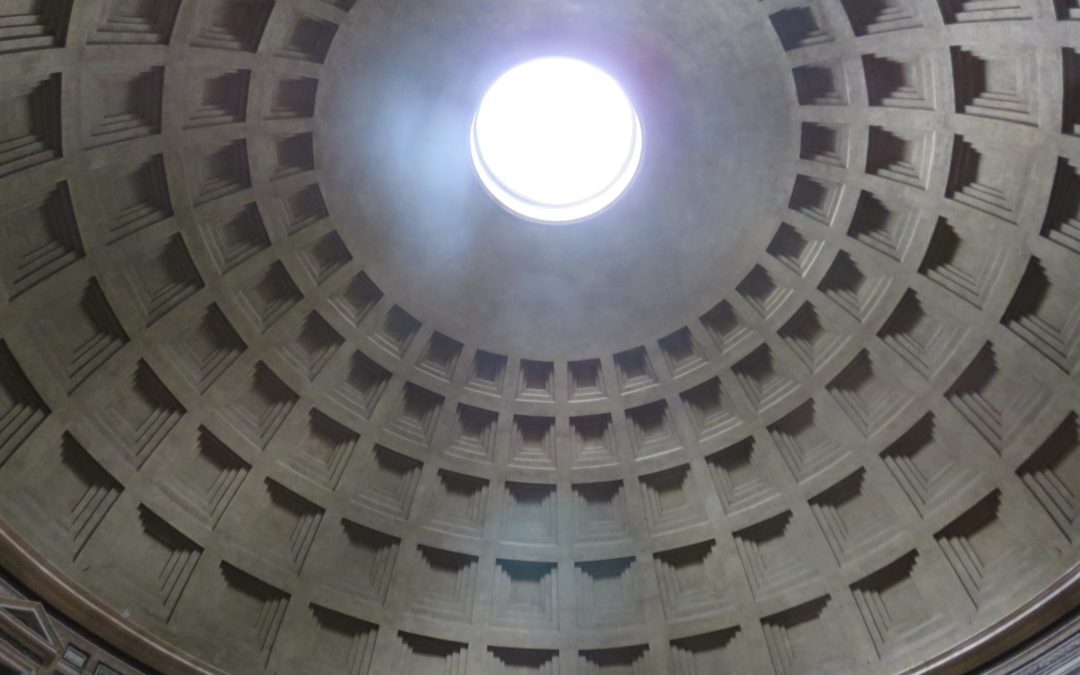Imagine you are in ancient Rome inside the famous building, the Pantheon, and it is noon on April 21—the traditional anniversary date for the birth of Rome. Light pours through a circular opening in the Pantheon’s massive domed roof, streaming down from above and pointing like a spotlight at the main door.
Suddenly, an imperial figure strides into the doorway, brightly lit up by the light pouring down from the ceiling. The figure is none other than Caesar Augustus, the emperor whom some declared to be a living god.
Pretty dramatic stuff.
My wife and I were in Rome last fall, and one of the guides at the Pantheon said that such a light show might actually have been orchestrated during the time of Augustus. Even Stephen Spielberg would have been impressed with these Roman special effects if he had been around in 27 B.C., when the Pantheon was constructed.
The Pantheon (not to be confused with the Parthenon in Athens) means “of all the gods†in Greek, because the temple was first dedicated to the seven gods of the planets, according to the handy guidebook that I bought in Rome. But what many people do not know is that this temple to the gods was later converted to a Christian church in the early 600’s A.D.
In fact, my handbook said one of the legends is that at the very moment the Pantheon was dedicated as a Christian church, seven devils flew out of the sanctuary. One of those devils tried to break through the roof, where a giant golden pinecone acted as a lid, closing up the circular hole known as the “oculus.†That pinecone was knocked loose, and you can now find it in the Vatican’s “Court of the Pinecone.â€
Today, the Pantheon remains a church—the Basilica of St. Mary of the Martyrs. And inside you can find magnificent art, as well as the tomb of Raphael, the great artist (not the Ninja Turtle).
But what fascinated me most is the Pantheon’s “oculusâ€â€”the open hole in the center of the ceiling that lets light inside. Another legend says that whenever it rains, the sprinkles coming in through the oculus will evaporate before they strike the floor; therefore, it never rains inside the Pantheon. We had idyllic weather when we were in Italy, but ironically the only rain we experienced was for twenty minutes while we visited the Pantheon. So I can attest that the drizzle did not evaporate before it came through the oculus and hit the floor of the church.
I would especially love to be at the Pantheon on Pentecost, which celebrates the day that the Holy Spirit came down on the apostles like flames of fire. To symbolize the descent of these flames, thousands of red rose petals shower down on the people below.
On December 23, the Winter Solstice, the light coming in through the oculus strikes high up on the inside of the Pantheon’s dome. And on the Summer Solstice, June 21, the sunlight forms a large circle on the interior floor. On the two equinoxes, one on March 21 and the other on September 23, the light through the oculus strikes the grate of the window directly above the massive entry door, hitting the pavement on the Pantheon’s porch.
Finally, on April 21, the day commemorating the founding of Rome, the light strikes the doorway head-on.
Light is a powerful symbol for this famous building, which was converted from a temple dedicated to many gods to a church devoted to one God. The building moved from darkness to light.
As Jesus says in Matthew 4:16: “The people living in darkness have seen a great light; on those living in the land of the shadow of death a light has dawned.â€
Or, to quote another passage from Matthew, this one 5:14-16, “You are the light of the world. A town built on a hill cannot be hidden. Neither do people light a lamp and put it under a bowl. Instead they put it on its stand, and it gives light to everyone in the house. In the same way, let your light shine before others, that they may see your good deeds and glorify your Father in heaven.â€
Rome was a city built on seven hills. But we are like a town built on a single hill, and the light we give out is not intended to illuminate ourselves, as the light striking Caesar Augustus once did. Ours is reflected light from God, intended to illuminate Jesus, and that’s something no special effects artist can recreate. Not even Stephen Spielberg.
By Doug Peterson


